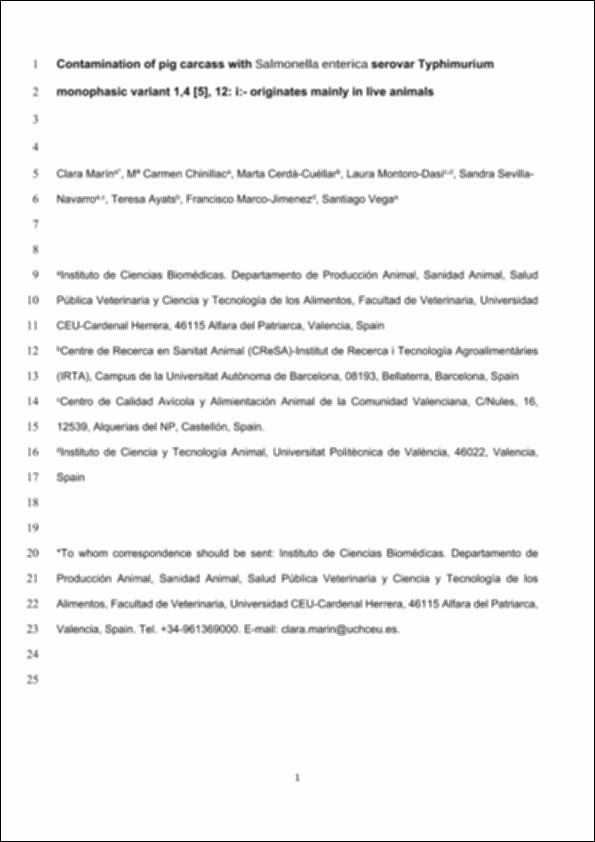Please use this identifier to cite or link to this item:
http://hdl.handle.net/10637/13480Contamination of pig carcass with "Salmonella enterica" serovar "Typhimurium monophasic" variant 1,4[5],12:i:- originates mainly in live animals
| Title: | Contamination of pig carcass with "Salmonella enterica" serovar "Typhimurium monophasic" variant 1,4[5],12:i:- originates mainly in live animals |
| Authors : | Marín Orenga, Clara Chinillach Andreu, María Carmen Cerdà Cuéllar, Marta Montoro Dasí, Laura Sevilla Navarro, Sandra Ayats, Teresa Marco Jiménez, Francisco Vega García, Santiago |
| Keywords: | Cerdos - Enfermedades infecciosas.; Salmonellosis in animals.; Slaughtering and slaughter-houses - Quality control.; Salmonelosis en los animales.; Mataderos - Control de calidad.; Swine - Communicable diseases. |
| Publisher: | Elsevier |
| Citation: | Marin, C., Chinillac, M. C., Cerdà-Cuéllar, M., Montoro-Dasi, L., Sevilla-Navarro, S., Ayats, T., Marco-Jimenez, F. & Vega, S. (2020). Contamination of pig carcass with "Salmonella enterica" serovar "Typhimurium monophasic" variant 1,4[5],12:i:- originates mainly in live animals. Science of the Total Environment, vol. 703 (10 feb.), art. 134609. DOI: https://doi.org/10.1016/j.scitotenv.2019.134609 |
| Abstract: | Pork is considered a major source of Salmonella Typhimurium infection in humans in the EU, including monophasic strains. Widespread distribution of virulent serotypes such as monophasic variants of S. Typhimurium have emerged as a public health threat. Despite the current situation, within the EU there is no mandatory programme for the control of Salmonella at pork production level. In this context, the aims of this study were: to examine the presence of Salmonella in the swine production system from arrival at the slaughterhouse until the end of processing, and investigate the genetic relationship among the Salmonella serovars isolated. During the study, a total of 21 pig herds were intensively sampled during processing at the slaughterhouse. ERIC-PCR was performed among isolates recovered at the different steps in the slaughterhouse to assess the genetic relationship. Then, PFGE was done to study the pulsotypes among the different Salmonella serovars isolated. The results showed a high level of Salmonella pork batch contamination upon arrival at the slaughterhouse (71.4%) and at the end of the slaughtering process (66.7%), with mST the main serovar isolated from both origins (53.1% and 38.2%, respectively). The slaughter environment poses a potential risk for carcass contamination and it is considered an important source of Salmonella spp. Similarly, this study shows that 14.3% of the strains isolated from carcasses have the same Xbal-PFGE profile as those previously recovered in the slaughterhouse environment, but not in the live animals from that same batch. In conclusion, there is a high level of Salmonella swine batch contamination upon arrival at the slaughterhouse and at the end of the slaughtering process, mST being the most frequently isolated serovar. Moreover, a strong genetic relationship has been observed between Salmonella strains isolated from the batch on arrival at the slaughterhouse, the processing environment and pork carcass contamination. In this sense, it would be necessary to implement a control programme to reduce the bacterium from pork farms and raise the awareness of biosecurity measures. |
| Description: | Este artículo se encuentra disponible en la siguiente URL: https://www.sciencedirect.com/science/article/abs/pii/S0048969719346005?via%3Dihub This is a pre-print of an article published in Marin, C., Chinillac, M. C., Cerdà-Cuéllar, M., Montoro-Dasi, L., Sevilla-Navarro, S., Ayats, T., Marco-Jimenez, F. & Vega, S. (2020). Contamination of pig carcass with Salmonella enterica serovar Typhimurium monophasic variant 1,4[5],12:i:- originates mainly in live animals. The Science of the total environment, vol. 703, art. 134609. The final authenticated version is available online at: https://doi.org/10.1016/j.scitotenv.2019.134609 Este es el pre-print del siguiente artículo: Marin, C., Chinillac, M. C., Cerdà-Cuéllar, M., Montoro-Dasi, L., Sevilla-Navarro, S., Ayats, T., Marco-Jimenez, F. & Vega, S. (2020). Contamination of pig carcass with Salmonella enterica serovar Typhimurium monophasic variant 1,4[5],12:i:- originates mainly in live animals. The Science of the total environment, vol. 703, art. 134609, que se ha publicado de forma definitiva en https://doi.org/10.1016/j.scitotenv.2019.134609 |
| URI: | http://hdl.handle.net/10637/13480 |
| Rights : | http://creativecommons.org/licenses/by-nc-nd/4.0/deed.es |
| ISSN: | 0048-9697 1879-1026 (Electrónico) |
| Issue Date: | 10-Feb-2020 |
| Center : | Universidad Cardenal Herrera-CEU |
| Appears in Collections: | Dpto. Producción y Sanidad Animal, Salud Pública Veterinaria y Ciencia y Tecnología de los Alimentos |
Items in DSpace are protected by copyright, with all rights reserved, unless otherwise indicated.


